Thing 4, this was enblogening. So now I understand how to actually do RSS feeds, and I listed the blogs I am following on my blog. And I began a blog reader in my new Google blog reader account, which interacts with my blog and the blogs I have now decided to blog about in a list of blogs, that is now presented (as previously mentioned) on my blog.
But seriously, it is good to gain an understanding of how all this works. It is possible that I can find a good use for all this here in the library. For me personally, as stated before, I have no interest in most things bloggy. There is one blog that I like to read, and that is Christopher Moore’s. I have it listed to the left there. He is one of my favorite writers, very funny, and has a well rounded perspective on life, at least as far as I am concerned. Other than that, I just don’t find most of the blogs that I have run across in the huge realm of the www to be interesting. What I have noticed is a strong inclination of many bloggers to take themselves way too seriously. I might find one or two that could be of interest through this program, but I’m not really all that concerned if I don’t.
That said, I am enjoying the sharing environment that we have going here in 23 Things, and I like to read through other participants thoughts. This is a nice setting for asynchronous learning. So now I am following some of the other 23 Thingers, and look forward to continue to draw from all of our experiences.
Thing 22 Staying Current
15 years ago





